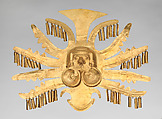Headdress Ornament
Not on view
Five lateral rays project out from either side of this gold Calima headdress ornament, surrounding central crescent-shaped projections located both above and below a central face rendered in high relief. When worn, the lower central crescent-shaped element would have covered the wearer’s forehead and nose. The rays may have been designed to emulate the plumage of an elaborate feather headdress with their slightly curved forms with three notched triangular elements and linear designs. Every other ray has a series of dangling pendants attached by small gold wires, increasing in number from six to eight to ten, successively from top to bottom, with three pendants missing from the bottom ray on the right. When the wearer moved, these pendants would have swayed back and forth, producing a tinkling sound. This combination of sound and motion would have animated the piece in a dramatic fashion.
The face in high relief at the center of the headdress ornament wears a dome-shaped cap with two small rectangular forms above the forehead. Two large, circular, convex ear pendants with concave circular forms at the centers hang from gold wires. An H-shaped nose pendant covers the mouth and lower face, exposing only the closed or squinted eyes. The nose pendant itself bears a smaller, more stylized face in low relief. Through layers of adornment and repetition, this headdress ornament simultaneously reveals and conceals faces.
The H-shaped nose pendant is a hallmark of Yotoco-period Calima art. The Yotoco period was the second of three societies—Ilama, Yotoco-Malagana, and Sonso—to successively occupy the Cauca Valley region in west-central Colombia. The three societies are known collectively as the Calima culture. Faces in Yotoco artwork are often inexpressive, and represent idealized types rather than true portraiture. This type of face is also commonly found on pectorals (see 1979.206.507), where they also bear little to no variation in features across different pieces. Some scholars have suggested stylistic similarities between Calima gold figures and the stone sculptures found at San Agustín, an archaeological site in west-central Colombia, due to the recurrence of impassive faces with dome-shaped caps as a central motif.
The gold in this piece was first hammered into a sheet and subsequently cut into the desired shape. The artist then added details by further shaping the sheet with a bone or metal tool over a soft anvil made of leather or a sack of fine sand. It is likely that the face in high relief was sculpted over a mold.
This type of headdress ornament, often called frontals as they would have been affixed to the front of a turban-like textile or basketry headdress, would have served as a resplendent manifestation of status and wealth. The gold frontal, with its delicate, moving pendants, would have caught and reflected sunlight, or even fire light. Headdress frontals would have been worn as part of a suite of ornaments with similar iconographic elements that adorned the torso, neck, and head, almost entirely obscuring the face (see 66.196.23, 1974.271.51, and 1979.206.506). Dressed in full regalia, Calima elites would have shone brightly, channeling the sun’s divinity and force as a source of life and renewal.
Andrés A. Bustamante, 2015
Further Reading
Botero, Clara Isabel, Roberto Lleras Pérez, Santiago Londoño Vélez, and Efraín Sánchez Cabra. The Art of Gold, the Legacy of Pre-Hispanic Colombia: Collection of the Gold Museum of Bogotá. Mexico, D.F.: Fondo de Cultura Económica, Banco de la República, 2007.
Jones, Julie, ed. The Art of Precolumbian Gold: The Jan Mitchell Collection. New York: Metropolitan Museum of Art, 1985.
Jones, Julie, and Heidi King. "Gold of the Americas." The Metropolitan Museum of Art Bulletin, vol. 59, no. 4 (Spring, 2002).
Pérez de Barradas, José. Orfebrería Prehispánica de Colombia Estilo Calima. Bogotá, Colombia: Banco de la República, 1954.
Morand, Marie Claude. Calima: Colombie précolombienne. Martigny, Switzerland: Foundation Pierre Gianadda, 1992.
Cardale de Schrimpff, Marianne, ed. Calima and Malagana: Art and Archaeology in Southwestern Colombia. Bogotá, Colombia: Pro Calima Foundation, 2005.
Due to rights restrictions, this image cannot be enlarged, viewed at full screen, or downloaded.


